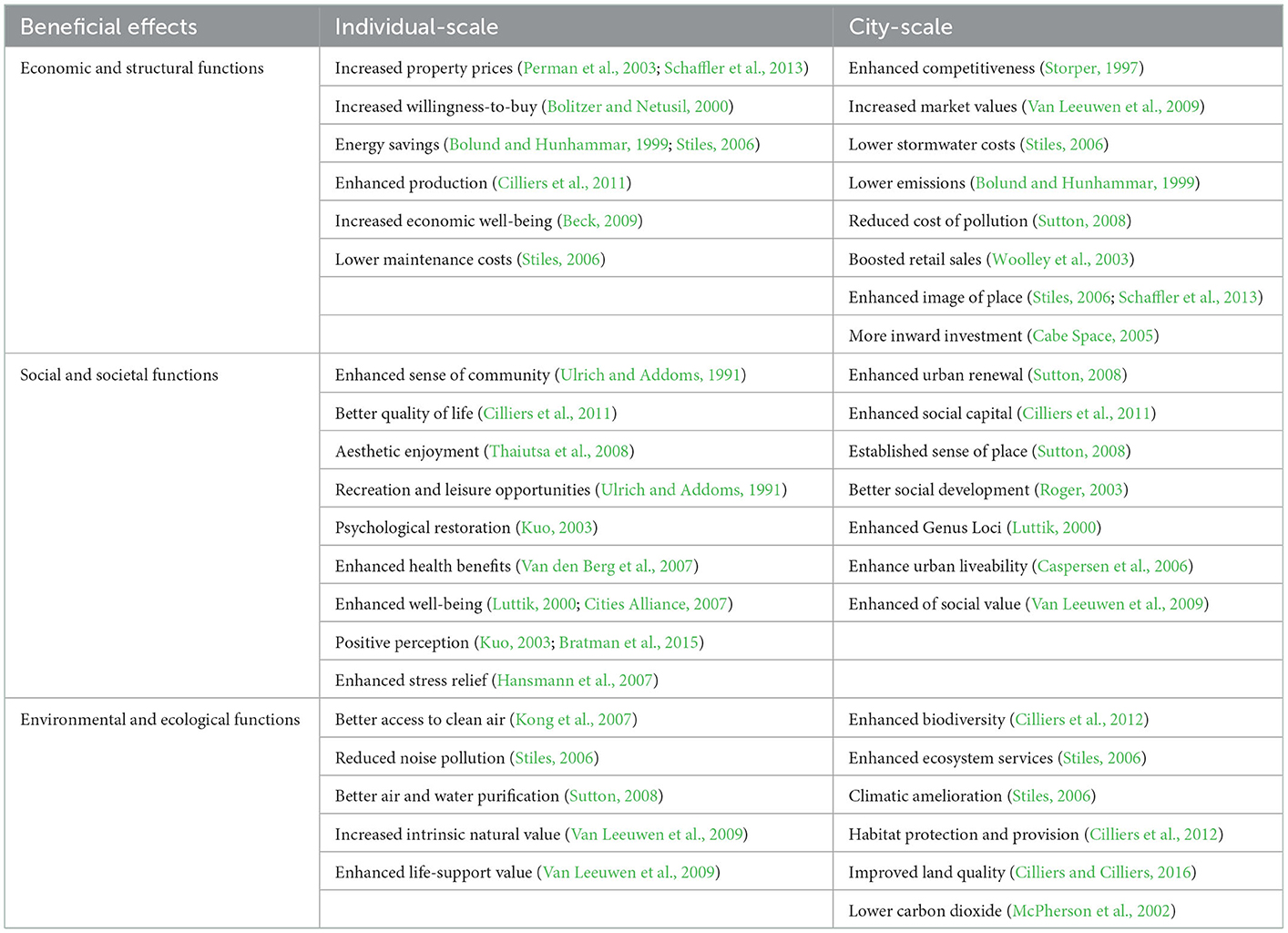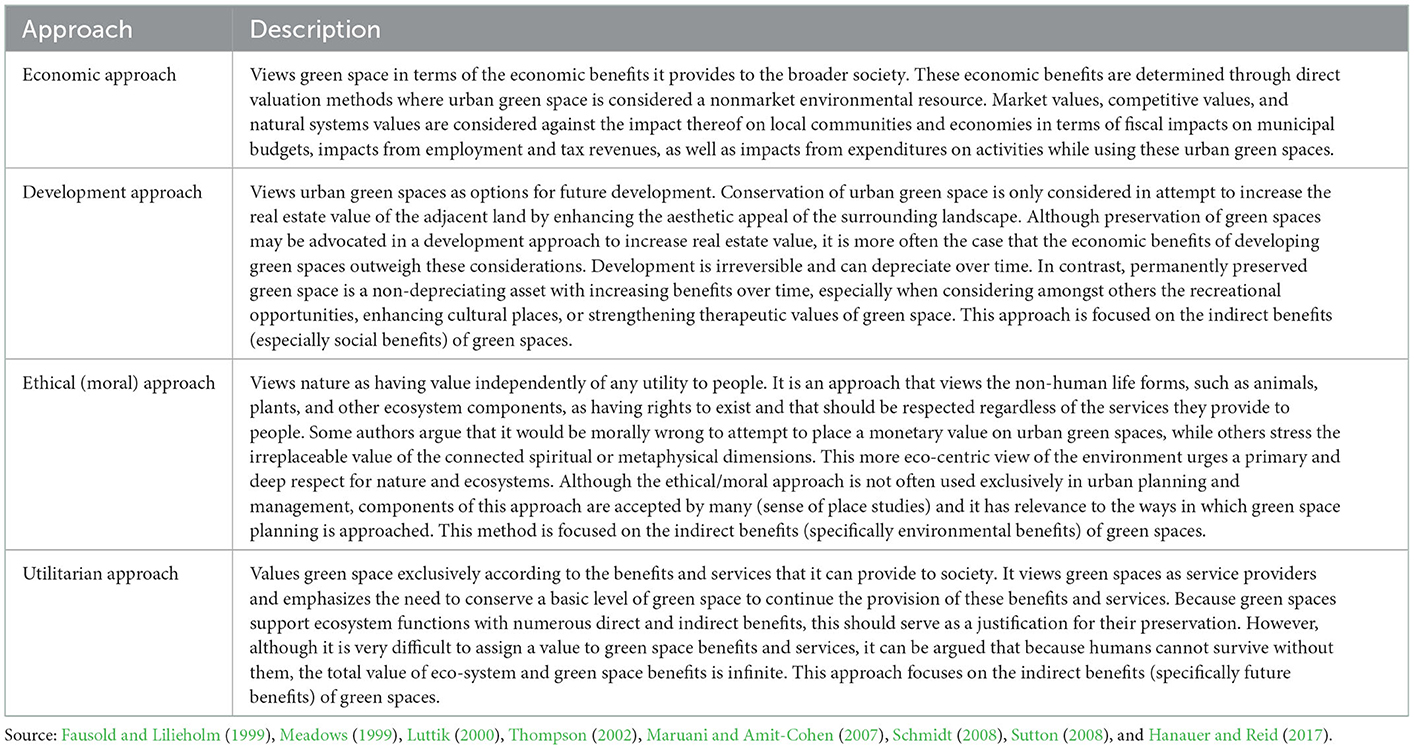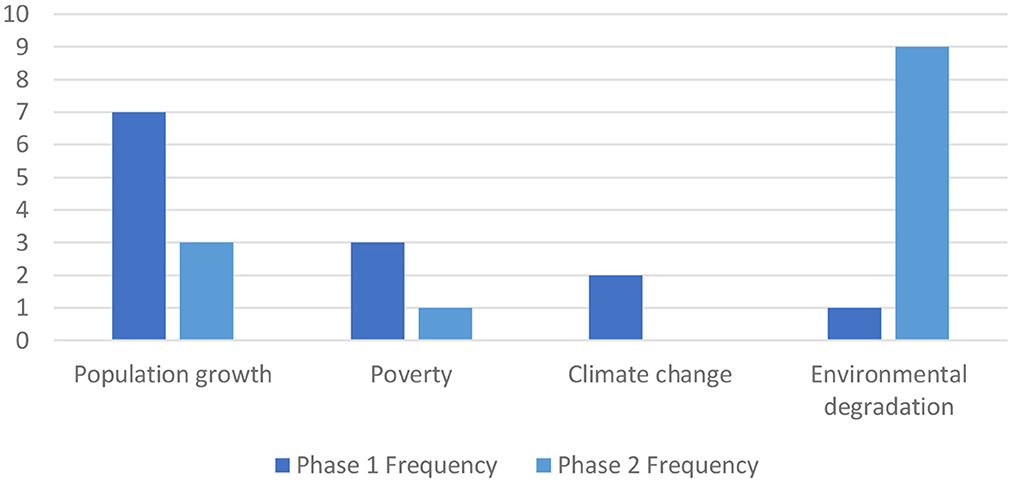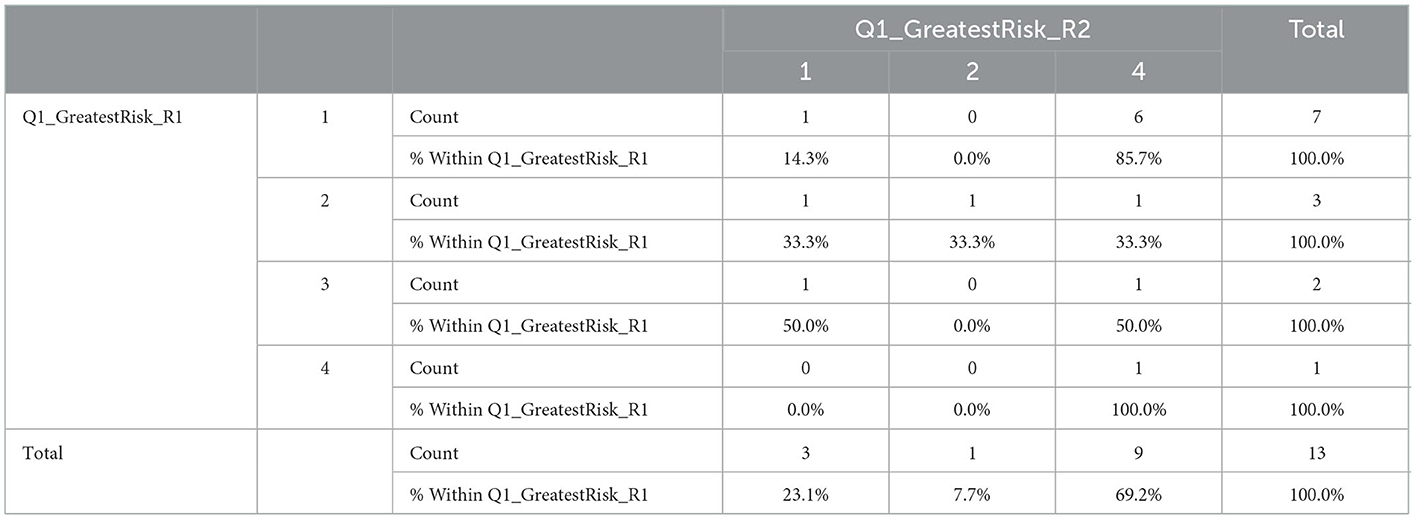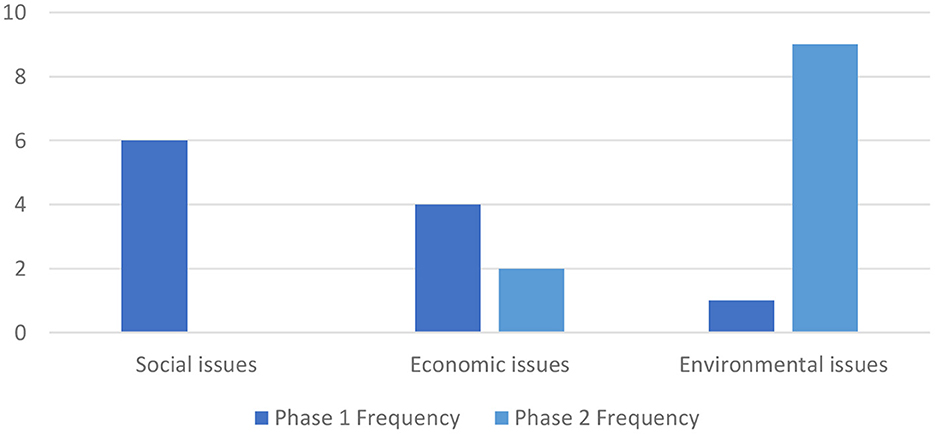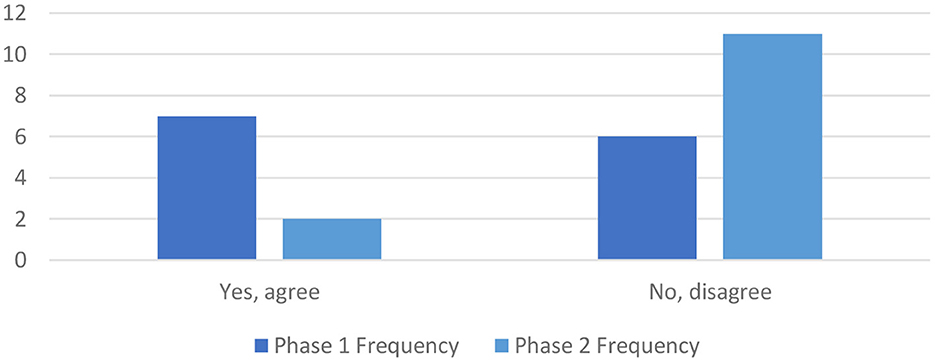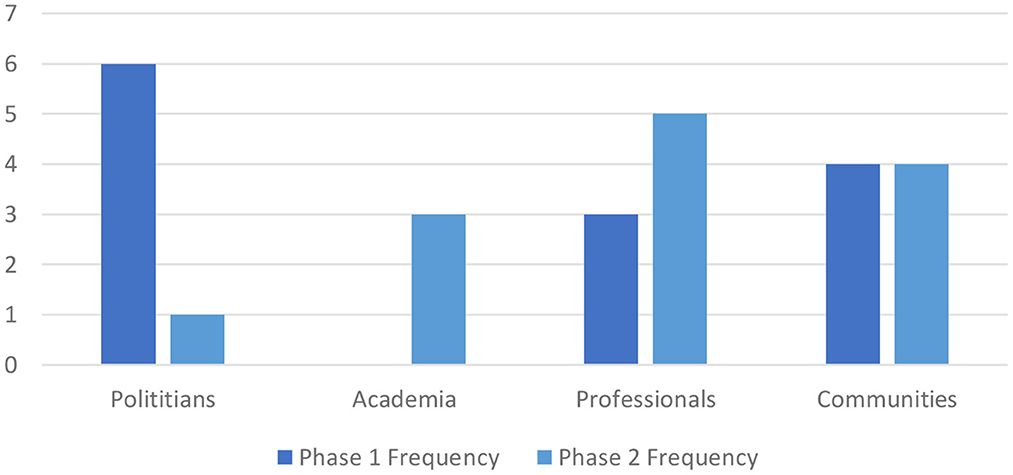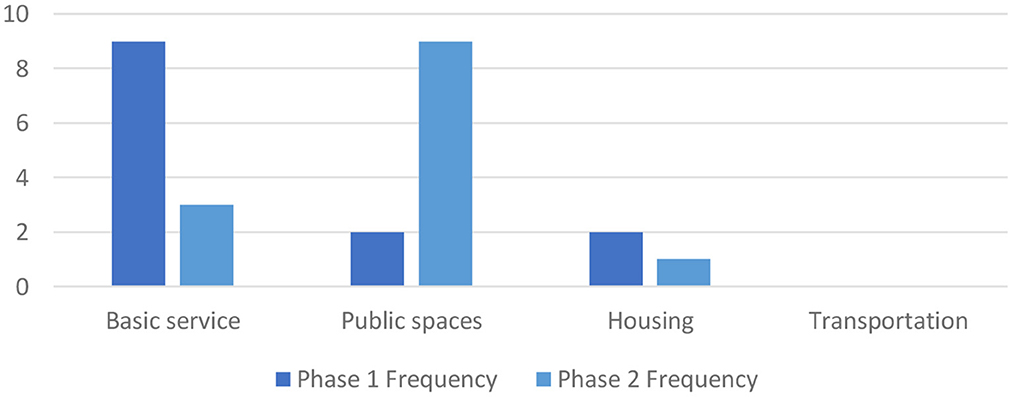- 1Unit for Environmental Sciences and Management, North-West University, Potchefstroom, South Africa
- 2School of Built Environment, University of Technology Sydney, Ultimo, NSW, Australia
Despite the expanding scientific understanding that green spaces are substantially beneficial to urban communities and their host cities, along with the evidence that some global cities are making progress to include nature as part of mainstream planning, this article argues that social perceptions also play a critical part in the successful planning and realization of urban green space provision in practice, especially in the Global South. This research thus reflected on the pedagogical effect on the social perception of the presence of green spaces in an urban area. To understand the impact of social perceptions on the valuation of green spaces, this article investigated the views of a convenience sample of professionals working in the Built Environment in South Africa and employed frequency distribution, two-way frequencies, and statistical measures to draw conclusions pertaining to the perception of green space value. The research illustrated that social perceptions inform how urban risks are perceived and that these perceptions of green space are often limited due to a lack of knowledge and awareness. The research exemplified that the actual community benefit provided by green spaces should be better articulated to gain traction in practice and that the appreciation and use of these urban green spaces should also be understood from a context-based and personal valuation perspective, to position these spaces as the critical resource and public good. This research concluded that social perceptions should be comprehensively understood, especially in the quest of realizing green(er) spaces and cities in the Global South.
1. Introduction
Urban green spaces include spaces in the urban landscape that are in a natural, undeveloped, or developed state located in proximity to the urban core (Cilliers et al., 2015). Urban green spaces are predominantly natural areas, with a sense of quality and the presence of maintained facilities (Shackleton and Blair, 2013). Such spaces include natural (vegetated), accessible public spaces with maintained facilities that add a specific quality to communities, including social, ecological, economic, psychological, health, and amenity functions (Stiles, 2006; Sutton, 2008). Urban green space is often referred to as “open space,” “open areas,” “green space,” and “public space,” related to the way that it is valued and viewed by its users. Apart from the lack of a universal definition of what urban green space entails, there is also no general typology for green space due to diverging natural conditions (geomorphological, climatic, and biological), historical backgrounds, and social demands linked to different contexts (Cvejić et al., 2015, p. 9–10; Koc et al., 2017, p. 32).
For purposes of this article, the term “urban green spaces” is used with the understanding that contribute to a wide range of ecosystem services and other functions in urban areas, irrespective of the natural conditions or social context, and that these broad services include among others the reduction in negative impacts of urbanization on the surrounding environment; ameliorating the climate of urban areas; removing of pollutants by air and water filtration, seed dispersal and pollination, water storage, filtration, and drainage, protection from disasters such as landslides and storms; or providing pest and human disease regulation among others (Gómez-Baggethun and Barton, 2013, p. 178). Seeing that regulating services mostly indirectly benefit humans, these services are often less obvious to the general public (Langemeyer, 2015, p. 45). These important benefits, however, relate to a positive impact on urban land prices, as well as to maintaining and improving the quality of life and the health and wellbeing of citizens (Stiles, 2006, p. 11) and should perhaps be better articulated to substantiate the value of urban green spaces, especially since the market for environmental goods such as urban green spaces does not yield an observable unit price (unlike the market for most tangible goods), which then makes it more difficult to quantify. Previous research aimed to determine the value of such environmental goods by using direct elicitation of willingness to pay, travel costs, advertising costs, direct monetary damages, the household production approach, or some combination of the above (Brasington and Hite, 2005, p. 4). The most common qualitative evaluation methods include, but are not limited to the following (Lambert, 2003, p. 7): (1) the market price method based on the law of supply and demand, (2) the damage cost avoided, replacement cost or substitute cost method that use values where the value can be estimated from the substitute cost, (3) the contingent valuation method relating to willingness to pay for specific environmental services, (4) the contingent choice method by considering trade-offs among sets of ecosystem or environmental services, (5) the benefit transfer method that estimates economic values by transferring existing benefit estimated from studies already completed for another location or context, (6) the productivity method that estimates the economic values for green space products or services that contribute to the production of commercially marketed goods, and (7) the hedonic pricing method that considers indirect use, future use and non-use values. Various authors have conducted research to quantify the value of urban green spaces and the collective results and beneficial effects of urban green spaces are now mainly grouped into three broader themes: environmental and ecological functions, social and societal functions, and economic and structural functions, as summarized in Table 1. These beneficial effects of urban green can further be divided into individual-scale and city-scale benefits, as illustrated in Table 1.
These studies on the quantification of the value of urban green spaces aimed to emphasize green value and not put a price tag on the environment (Korsgaard and Schou, 2010). Some authors argue that environmental valuation is needed since “pricing nature” allows it to be better managed alongside other goods and services (Hajkowicz, 2007). These valuation methods and results are, in most cases, location-specific and are an estimate of the indirect and direct values associated with urban green spaces (Cilliers and Cilliers, 2015). However, such research, based on the economic valuation of urban green spaces, has provided good insights into the realization that the earth provides only limited resources that can be exhausted if not conserved, supporting the concept of “tragedy of the commons” (Hardin, 1968) when a scarce resource is depleted.
The majority of previous research conducted on the value of urban green spaces related to the assumed benefits based on the presence (or abundance) of these spaces, and few studies focused on the quality of these spaces (Stessens et al., 2020). There is an increasing realization of the importance of assessing urban green space quality (Madureira et al., 2018) since it is evident that lower-quality areas of green space may be less beneficial to facilitating a physical activity or a restorative experience, irrespective of the abundance of such green space (Stessens et al., 2020). This is especially true in the South African context where the quality of green space provision extends across socioeconomic scales. Rural areas in South Africa are often confronted with pressing needs such as the provision of basic services (as defined by UN-Habitat, 2016 as water, sanitation, drainage, energy, and transport which are key ingredients for the economic and social development of urban areas), as well as housing and infrastructure, that is all due to be delivered within limited budgets and timeframes, which then results in green space provision being often under-prioritized in these rural contexts (Cilliers and Cornelius, 2019) as captured in Table 2. As a result, these rural areas are deprived of the social, environmental, and economic benefits, and associated ecosystem services that green spaces could offer. de Souza and Torres (2021) recognized the contextual challenges and illustrated how this is also true between the Global North and South, with evident differences in social, economic, political, and cultural dynamics as well as institutional structures. Drawing on the extensive value of green spaces, based on the majority of reaching conducted in the Global North, these spaces should rather be considered a basic human right and essential good to be provided, especially in areas of low socio-economic status, as in the Global South. In this sense, it is evident why access to urban green spaces is considered a social justice issue (Lopez et al., 2020), given the recognition of the life value of these spaces.
The equal distribution of green spaces, as well as the quality of these spaces, will thus progressively sensitize decision-makers and planners to consider the value of these spaces across different socio-gradients. Valuation approaches could further contribute to this agenda, by sensitizing planners, policymakers, and the public to understand the value of urban green spaces as a first step (Luttik, 2000; Roberts et al., 2005), and second, encourage urban decision-makers to embed sustainability thinking into city planning approaches. The value of “common” goods is becoming more prominent but currently remains limited to the perception of users, in this case, the subjective valuing of urban green spaces as a “common good” or “public good,” linked to the own understanding and appreciation of these spaces. Subsequently, personal valuation and appreciation of urban green spaces also impact the planning approach related to these spaces, as explained accordingly and further evidenced from the empirical investigation of this article.
2. Understanding the approaches to plan urban green spaces
A literature review of green space planning approaches and methods identified four broad approaches that are evident when considering the planning of urban green spaces, including (1) the economic approach, (2) the development approach, (3) the ethical or moral approach, and (4) the utilitarian approach, as described accordingly. A mixed-method approach is often evident in the contemporary urban space, drawing on various elements of these approaches.
Despite these articulated approaches aimed at enhancing green space planning and provision, governments across the globe are experiencing a widening gap between planned green space requirements and actual green space provision (Hashem, 2015; Boulton et al., 2018). Increasing land values and competing for economic demands of diverse urban communities (Byrne and Sipe, 2010), alongside compelling social, economic, and environmental imperatives, are prominent planning challenges of the 21st century (Boulton et al., 2018), leaving many cities now with the challenge to ensure that adequate areas of green space are provided and maintained, across a wide socio-economic gradient, to conform to the expectations of urban inhabitants. This is no new phenomenon, as the same challenges were widely debated over the past few decades, following the work of Jacobs (1961), Gold (1973), and Wilkinson (1985) among others, which emphasized the importance of understanding green space supply and demand, relative to population needs (Boulton et al., 2018). The task is, however, becoming increasingly difficult due to population growth and the sheer speed and scale of urbanization, with projections showing that the current trends could lead to the addition of a further 2.5 billion people within the urban landscape by 2050, simultaneously implying an exacerbating pressure on already strained resources, and a situation that would see the contemporary urban landscape far removed from the safe, clean, and liveable environment which it is envisioned to be (United Nations, 2021).
The critical state of the urban environment, the global decline in green space provision (Cilliers, 2019), the urgency to address global social issues related to climate impacts among others, and the recognition of the value of commons reiterated the importance to reintroduce green space valuation approaches, along with sensitizing all survey participants about the direct and indirect benefits of these spaces, for both the individual and the host city. The more recent concept of resilience draws on this approach, in which urban green space provision plays a critical part through its ability to withstand, adapt, and thrive in the face of perturbations (Jun and Conroy, 2014, p. 904). The urban landscape, a “complex ecological entity” (Alberti et al., 2003), calls upon ecological principles to be recognized as a sine qua non for sustainable cities (Liu et al., 2007; Stigsdotter, 2008; Cilliers and Cilliers, 2015, 2016) and requires green spaces to be the catalyst stimulating and enhancing the sustainability of an area. In theory, there are adequate reasons and supporting evidence to urge the prioritization of green space planning and provision, but in practice, it still seems limited and approached in an ad hoc manner, especially in the Global South (Cilliers, 2019). The constant conflict among land uses, conservation, and development pressures (Cilliers et al., 2015), along with budget constraints and fast-changing societal needs are some of the reasons why green space provision is not adequately met in practice, but the subjective valuation of these spaces might also be a critical part of the problem. Urban planning professionals responsible for urban green space provision need to better understand the linked ecosystem services which green spaces provide, as well as the direct and indirect benefits to both individuals and cities in general (Boulton et al., 2018). To further understand the impact of social perceptions on the valuation of green spaces, this article investigated the views of a focus group of professionals working in the Built Environment in South Africa, as captured in the empirical section of this article.
3. Empirical investigation to understand social perspectives of urban green space
In an attempt to unpack the impact of social perceptions on the valuation of green spaces, this article investigated the views of a focus group of professionals working in the Built Environment in South Africa, with the aim to understand how individuals view urban risks and priorities, the value of urban green spaces, along with their appreciation and use of such spaces.
3.1. Methodology
The research followed a survey-based study, as part of exploratory research into understanding the social perceptions of the value of green spaces. Survey-based research is conducted without predetermined notions of the expected responses (Ponto, 2015). Such surveys are often used to describe and explore human behavior and are frequently used in social and psychological research (Singleton and Straits, 2009).
The research design followed a quantitative approach, employing a ranking system to understand the perceptions in terms of urban risk, current urban issues, green space valuation, community needs, and the perceived decision-makers of the urban landscape. The survey comprised two phases, with both phases performed during a 1-day workshop. Phase one of the survey was conducted before the environmental awareness lecture on “the value of green spaces,” and the second phase was conducted after the environmental awareness lecture. The same questions were posed in both phases, in an attempt to compare the changes in responses before and after the “awareness” and sharing of information about the value of green spaces. The questions were abstracted from the urban green valuation approaches as was discussed in the literature section of this article. A total of 24 variables have been considered throughout four questions covering all the aspects of green spaces, including Question 1 which investigated the perception of participants pertaining to the urban risk from a social perspective, giving options of population growth, poverty, climate change (and linked societal issues), and environmental degradation. The second question investigated perceptions about the more crucial and current urban issues, asking participants to choose the most prominent between social, economic, or environmental issues, acknowledging that there is mostly overlap between these dimensions. Question 3 stated that “green spaces are a luxury” and investigated the participant perception of such. Accordingly, question 4 identified community needs and asked participants to identify the most prioritized according to their understanding, choosing between basic services, public spaces, housing, and transportation provision. Finally, participants were asked who they perceived as the decision-making authority for steering the urban goal, with options comprising of politicians, academic, professionals and communities.
The survey was composed of a convenience sample of participants who formed part of a predetermined group of 13 professionals, who had at least 2 years of working experience in the Built Environment in South Africa, and who enrolled in the 2019 Disaster Risk Management Workshop, as part of a collaboration project between the World Bank and North-West University. All participants were considered informed survey participants to comment on environmental issues in the urban landscape, based on their prior education relevant to the Built Environment, and associated experience.
The survey analysis descriptive statistical method comprised a frequency distribution, two-way frequencies, and statistical measure.
The frequency distribution considered the quantitative values of variables included in the data set and the associated number of times each value occurred (frequencies). It supported the interpretation of the data and detected outliers (extreme values) in the survey data set.
Two-way frequencies were accordingly conducted to support a visual representation of the possible relationships between the two phases of the categorical data, which illustrated how the answers of survey participants changed from phase 1 to phase 2, following the environmental awareness lecture.
Accordingly, a statistical measure was conducted to describe the whole set of data with a single value that represents the middle or center of its distribution; thus, how many survey participants' answers remained the same vs. how many of their answers changed between the two phases of the survey.
The p-values were reported for completeness sake but were not interpreted since a convenience sample was used instead of a random sample (Ellis and Steyn, 2013). These analyses informed the thematic findings that were identified through the investigation, as presented accordingly.
3.2. Thematic findings of the empirical investigation
This article reports on selective results that were obtained from the empirical investigation, including (1) the perception of urban risks (challenges) and priorities, (2) the perceptions of green space, and (3) the recognition of user value as explained accordingly.
3.2.1. Perception of urban risks and priorities
Focus group members were asked to identify the current greatest urban risk in terms of (1) population growth, (2) poverty, (3) climate change, or (4) environmental degradation. Prior to the environmental awareness lecture, the majority (53.8%) indicated that population growth was the single most challenging factor in the urban landscape, and only 2.6% noted environmental degradation as an urban risk, whereas this shifted after the lecture, with 69.2% (the vast majority) of respondents now recognizing environmental degradation as the core risk, as illustrated in Figure 1.
The two-way frequency analysis indicated the greatest change (85.75%) being from option 1 (population growth) to option 4 (environmental degradation), as illustrated in Table 3. The statistical measure indicated an overall change of 76.92% in responses between the first and second phases of the survey.
Accordingly, the survey participants were asked to indicate the most important urban issue to address in the contemporary urban landscape, with the choice among (1) social issues, (2) economic issues, and (3) environmental issues. The first phase had the majority of survey participants (54.5%) indicating social issues to be the dominating concern to address, whereas in phase 2 no participant opted for social issues, but the vast majority (81.8%) opted for environmental issues following the understanding of the role and value of urban green spaces in cities and urban spaces alike, as illustrated in Figure 2.
The two-way frequency analysis indicated the greatest change (83.3%) being from option 1 (social issues) to option 3 (environmental issues), as illustrated in Table 4.
The statistical measure indicated an overall change of 81.82% in responses between the first and second phases of the survey.
3.2.2. Perceptions of green space
The perceptions of focus group members in terms of green space being perceived as a luxury were accordingly captured with a question posed whether green spaces are a luxury (not a necessity) and choice options: (1) yes, agree or (2) no, disagree, as illustrated in Figure 3. Aligned with previous research conducted, 53.8% responded and indicated (pre-lecture) that green spaces are indeed a luxury with more pressing needs to address in the urban environment. After the environmental awareness lecture, the trends change to the far majority (84.6%) realizing that urban green spaces are a necessity and sine qua non for future sustainable cities.
The two-way frequency analysis indicated the greatest change (71.4%) being from option 1 (yes) to option 2 (no), as illustrated in Table 5. The statistical measure indicated an overall change of 38.46% in responses between the first and second phases of the survey.
Respondents were also posed to comment on the drivers of green space provision, and the accountable parties to ensure the planning, provision, and maintenance of these spaces. The options provided included (1) politicians, (2) academia, (3) professionals, or (4) communities, as illustrated in Figure 4. A visible change from “politicians” in phase 1 (with a 46.2% vote) to “professionals” (38.5%) and communities (30.8%) in phase 2 was evident, with participants realizing the need to take ownership of these urban green spaces as collective public goods.
The statistical measure indicated an overall change of 61.54% in responses between the first and second phases of the survey and a constant response of 38.46%, thus participants who kept with their original answer of phase 1 again in phase 2, following the environmental awareness lecture.
3.2.3. Recognition of user value
Finally, the survey investigated user value in terms of identifying the current most pressing need as perceived from the community perspective, in terms of (1) basic services, (2) public spaces, (3) housing, or (4) transportation, as illustrated in Figure 5. Similar to the finding of the previous research, the far majority (69.2%) initially indicated the need to be “basic services” but after understanding the role and value that urban green spaces play in our built environment, and the associated direct and indirect benefits thereof, the far majority (69.2%) now recognized public space (urban green space) as the core user value.
The two-way frequency analysis indicated the greatest change (55.6%) being from option 1 (basic services) to option 2 (public spaces), as illustrated in Table 6.
The statistical measure indicated an overall change of 61.54% in responses between the first and second phases of the survey.
4. Findings of the research
The following conclusion is presented based on the literature review and empirical investigation presented in the preceding sections.
4.1. Social perceptions inform how urban risks are perceived
Population growth is perceived as the current greatest urban risk, and while conforming to literature pertaining to the challenges that the currently increasing trajectory might hold for the contemporary urban landscape, this research illustrated environmental degradation is often not understood in terms of impact, and when contextualized in terms of the role and benefits of green spaces, stakeholders perceive these environmental challenges as a greater risk as the current accept risk of population growth. Likewise, stakeholders change to see environmental issues as a more important urban issue to address (in comparison to social and economic issues) once they understand the service role of these spaces and the benefits it holds for cities and urban residents.
4.2. Perceptions of green space are often limited due to a lack of knowledge and awareness
In general, green spaces are often perceived as a luxury good and not as an essential service. These misconceptions about the value of green space contribute to the screw perception that individuals, communities, and authorities have about the necessity of urban green spaces within the urban landscape. This research illustrated how a broader awareness of the role and benefits of green spaces could sensitize stakeholders to better understand green spaces as a public good, drawing on a combination of the economic approach, development approach, ethical (moral) approach, and utilitarian approach. It was also evident from this research that green spaces are generally perceived to be the responsibility of authorities (politicians), but when contextualized as a public good, stakeholders identify professionals and communities as the key role players to drive the green agenda.
4.3. Stakeholders prioritize user values
When contextualized the value of public, (green) spaces are better understood and appreciated by stakeholders, enhancing the pressure to plan and deliver more such spaces. The demand for urban green spaces will further gain importance once stakeholders comprehend the benefits in terms of aesthetic enjoyment, recreation, and access to quality environments, driven by a sense of survival, and the intrinsic value of urban green spaces to sustain life. As the urban landscape is becoming more complex and confronted with multifaceted challenges, the call for an ecologically minded approach to spatial planning will be gaining importance and will lead to future spatial planning approaches.
4.4. Economic valuation methods contribute to building the case for urban green spaces
The fact that green spaces are not articulated in monetary terms may be the main reason for their susceptibility to urban pressures (More et al., 1988). While some authors claim the value of green spaces should be expressed in monetary terms to become comparable to economic elements of urban development and would then thus consequently have more weight in the decision-making process (Luttik, 2000), others feel much remain to be understood in regard to the magnitude, scope, and manifestations of green gentrification (Anguelovski et al., 2019). Ecological principles are not yet considered a sine qua non for sustainable cities in the South African context, and there is an increasing awareness that adaptive planning approaches (Ahern et al., 2014) should guide future planning processes toward broader environmental thinking and sustainable practices. The overall objective should be to orientate the broader public about the actual value of urban green spaces. The research confirmed that in this empirical investigation, the majority of survey participants were able to better understand the substantial benefits for individuals, communities, and cities, after the role and benefits of urban green spaces were contextualized, and they were likewise able to better comprehend the user value of urban green space as most pressing need going forward. Despite the limitations of the empirical research in terms of the convenience sample, the investigation still poses valuable insights into the social perceptions of the value of green spaces.
5. Conclusion and recommendations to look beyond the greenness and position urban green space value as a critical resource and public good
Based on the literature investigation and empirical survey conducted, this study argues that social perceptions should also be comprehensively understood in looking beyond the greenness, to emphasize the actual community benefit, appreciation, and use of urban green spaces, in the quest to prioritize urban green space provision on a global scale. To position urban green space as the critical resource and public good it ought to be, the following recommendations are proposed:
Communities and authorities need to realize and comprehend the value of urban green spaces, not only the social and environmental spin-offs but also the measurable economic benefit. The importance, necessity, and value of these urban green spaces should be understood, enhanced, and reflected in spatial planning processes, acknowledging that the value of green spaces is subjective, and linked to the perceptions and needs of communities and the character and function of an area, thus differentiating between people and places.
The extensive benefits of urban greening for both cities and communities, pertaining to social, economic, and health benefits; should be widely communicated and publicized to address current misconceptions and perceptions about the value of urban green spaces. This will enable the articulation of actual community benefits provided by green spaces and the appreciation and use of these urban green spaces from a context-based and personal valuation perspective, ultimately positioning these spaces as a critical resource and public good.
The “sustainability dividend” should be sought throughout all planning and developmental projects, drawing on environmental science and solutions to create and enhance real estate asset value, capitalizing on the value and ecosystem services of urban green spaces, and enhancing the ecologically minded approach to spatial planning.
Educational approaches should strengthen the perception of the irreplaceable value of urban green spaces and recognition of ecological principles as a sine qua non for sustainable cities to raise awareness and enhance knowledge about the value of such spaces.
Social perceptions should be better understood in an attempt to contextualize the value of green spaces. This is true for the Global South, as is for the Global North. What is evident from this investigation is that there are specific and unique considerations and context-based factors that impact social perceptions which would in return define the value of green space in the Global South.
Data availability statement
The raw data supporting the conclusions of this article will be made available by the authors, without undue reservation.
Ethics statement
The studies involving human participants were reviewed and approved by North-West University Ethics Committee. Written informed consent for participation was not required for this study in accordance with the national legislation and the institutional requirements.
Author contributions
The author confirms being the sole contributor of this work and has approved it for publication.
Conflict of interest
The author declares that the research was conducted in the absence of any commercial or financial relationships that could be construed as a potential conflict of interest.
Publisher's note
All claims expressed in this article are solely those of the authors and do not necessarily represent those of their affiliated organizations, or those of the publisher, the editors and the reviewers. Any product that may be evaluated in this article, or claim that may be made by its manufacturer, is not guaranteed or endorsed by the publisher.
References
Ahern, J., Cilliers, S., and Niemel?, J. (2014). The concept of ecosystem services in adaptive urban planning and design: A framework for supporting innovation. Landsc. Urban Plann. 125, 254–259.
Alberti, M., Marzluff, J. M., Shulenberger, E., Bradley, G., Ryan, C., and Zumbrunnen, C. (2003). Integrating humans into ecology: opportunities and challenges for studying urban ecosystems. BioScience 53, 1169–1179. doi: 10.1641/0006-3568(2003)053[1169:IHIEOA]2.0.CO;2
Anguelovski, I., Connolly, J. J., Garcia-Lamarca, M., Cole, H., and Pearsall, H. (2019). New scholarly pathways on green gentrification: What does the urban “green turn” mean and where is it going? Prog. Hum. Geogr. 43, 1064–1086. doi: 10.1177/0309132518803799
Beck, H. (2009). Linking the quality of public spaces to quality of life. J. Place Manag. Dev. 2, 240–248. doi: 10.1108/17538330911013933
Bolitzer, B., and Netusil, N. R. (2000). The impact of open spaces on property values in Portland, Oregon. J. Environ. Manag. 59, 185–193.
Boulton, C., Dedekorkut-Howes, A., and Byrne, J. (2018). Factors shaping urban greenspace provision: a systematic review of the literature. Landsc. Urban Plan. 178, 82–101. doi: 10.1016/j.landurbplan.2018.05.029
Brasington, D. M., and Hite, D. (2005). Demand for environmental quality: a spatial hedonic analysis. Reg. Sci. Urban Econ. 35, 57–82. doi: 10.1016/j.regsciurbeco.2003.09.001
Bratman, G. N., Daily, G. C., Levy, B. J., and Gross, J. J. (2015). The Benefits of Nature Cabe Space. 2005. Paying for Parks: Eight Models for Funding Urban Green Space. London: Routeldge. Available online at: http://www.cabe.org.uk/files/Paying-for-parks-full-report.pdf (accessed April 10, 2014).
Byrne, J., and Sipe, N. (2010). Green and open space planning for urban consolidation-A review of the literature and best practice. Griffith University, Queensland, Australia. Available online at: https://research-repository.griffith.edu.au/bitstream/handle/10072/34502/62968_1.pdf
Cabe Space. (2005). Paying for Parks: Eight Models for Funding Urban Green Space. London: Route. p. 1–6. Available online at: http://www.cabe.org.uk/files/Paying-for-parks-full-report.pdf
Caspersen, O. H., Konijnendijk, C. C., and Olafsson, A.S. (2006). Green-space planning and land use: An assessment of urban regional and green structure planning in Greater Copenhagen. Geografisk Tidsskrift, Danish J. Geograph. 106, 7–20.
Cilliers, E. J. (2019). Reflecting on green infrastructure and spatial planning in Africa: the complexities, perceptions, and way forward. Sustainability 11, 455. doi: 10.3390/su11020455
Cilliers, E. J., and Cilliers, S. S. (2015). From green to gold: a South African example of valuing urban green spaces in some residential areas in Potchefstroom. Town Plan. Rev. 67, 1–12.
Cilliers, E. J., and Cilliers, S. S. (2016). Planning for Green Infrastructure: Options for South African Cities. Johannesburg: South African Cities Network.
Cilliers, E. J., and Cornelius, G.S. (2019). The creation of rural child-friendly spaces: A spatial planning perspective. Appl. Res. Qual. Life. 14, 925–939. doi: 10.1007/s11482-018-9631-2
Cilliers, E. J., Diemont, E., Stobbelaar, D. J., and Timmermans, W. (2011). Enhancing sustainable development by means of the Workbench method. Environ. Plan. B Plan. Des. 38, 579–584. doi: 10.1068/b37111
Cilliers, E. J., Timmermans, W., Van Den Goorbergh, F., and Slijkhuis, J. S. A. (2015). Designing public spaces through the lively planning approach. Environ. Dev. Sustain. 2015, 1367–1380. doi: 10.1007/s10668-014-9610-1
Cilliers, S. S., Cilliers, E. J., Lubbe, C. E., and Siebert, S. J. (2012). Ecosystem services of urban green spaces in African countries—perspectives and challenges. Urban Ecosyst. 16, 681–702. doi: 10.1007/s11252-012-0254-3
Cities Alliance (2007). Liveable Cities: The Benefits of Urban Environmental Planning. A Cities Alliance Study on Good Practices and Useful Tools. Washington: York Graphic Services.
Cvejić, R., Eler, K., Pintar, M., Železnikar, S., Haase, D., Kabisch, N., et al. (2015). A typology of urban green spaces, eco-system services provisions services and demands. Report D3, 1. GREEN SURGE project (2013–2017). Available online at: https://greensurge.eu/working-packages/wp3/files/D3.1_Typology_of_urban_green_spaces_1_.pdf/D3.1_Typology_of_urban_green_spaces_v2_pdf (accessed May 5, 2020).
de Souza, D. T., and Torres, P. H. C. (2021). Greening and just cities: Elements for fostering a south-north dialogue based on a systematic literature review. Front. Sustain. Cities 3, 669944. doi: 10.3389/frsc.2021.669944
Ellis, S. M., and Steyn, H. S. (2013). Practical significance (effect sizes) vs. or in combination with statistical significance (p-values). Manag. Dyn. 12, 51–53.
Fausold, C. J., and Lilieholm, R. J. (1999). The economic value of open space: a review and synthesis. Environ. Manag. 23, 307–320.
Gómez-Baggethun, E., and Barton, D. N. (2013). Classifying and valuing ecosystem services for urban planning. Ecol. Econ. 86, 235–245. doi: 10.1016/j.ecolecon.2012.08.019
Hajkowicz, S. (2007). Can we put a price tag on nature? Rethinking approaches to environmental valuation. Aust. J. Environ. Manag. 14, 22–26, doi: 10.1080/14486563.2007.9725146
Hanauer, M. M., and Reid, J. (2017). Valuing urban open space using the travel-cost method and the implications of measurement error. J. Environ. Manag. 198, 50–65. doi: 10.1016/j.jenvman.2017.05.005
Hansmann, R., Hug, S. M., and Seeland, K. (2007). Restoration and stress relief through physical activities in forests and parks. Urban For. Urban Green. 6, 213–225. doi: 10.1016/j.ufug.2007.08.004
Hashem, N. (2015). Assessing spatial equality of urban green spaces provision: a case study of Greater Doha in Qatar. Local Environ. 20, 386. doi: 10.1080/13549839.2013.855182
Jun, H. J., and Conroy, M. M. (2014). Linking resilience and sustainability in Ohio township planning. J. Environ. Plan. Manag. 57, 904–919. doi: 10.1080/09640568.2013.775061
Koc, C. B., Osmond, P., and Peters, A. (2017). Towards a comprehensive green infrastructure typology: a systematic review of approaches, methods and typologies. Urban Ecosyst. 20, 15–35. doi: 10.1007/s11252-016-0578-5
Kong, F., Yin, H., and Nakagoshi, N. (2007). Using GIS and landscape metrics in the hedonic price modeling of the amenity value of urban green space: a case study in Jinan City, China. Landsc. Urban Plan. 79, 240–252. doi: 10.1016/j.landurbplan.2006.02.013
Korsgaard, L., and Schou, J. S. (2010). Economic valuation of aquatic ecosystem services in developing countries. Water Policy 12, 20–31. doi: 10.2166/wp.2009.124
Kuo, F. E. (2003). The role of arboriculture in a healthy social ecology. J. Arboricult. 29, 148–155. doi: 10.48044/jauf.2003.018
Lambert, A. (2003). Economic valuation of wetlands: an important component of wetland management strategies at the river Basin scale. Ramsar Convent. 2003, 10.
Langemeyer, J. (2015). Urban ecosystem services: the value of green spaces in cities (Doctoral dissertation). [Stockholm Resilience Centre]: Stockholm University
Liu, Z., Mao, F., Zhou, W., Li, Q., Haung, J., and Zhu, X. (2007). Accessibility Assessment of Urban Green Space: A Quantitative Perspective. Beijing: School Architecture, Tsinghua University, 2. doi: 10.1109/IGARSS.2008.4779245
Lopez, B., Kennedy, C., and McPhearson, T. (2020). Parks are Critical Urban Infrastructure: Perception and Use of Urban Green Spaces in NYC During COVID-19. doi: 10.20944/preprints202008.0620.v2
Luttik, J. (2000). The value of trees, water and open space as reflected by house prices in the Netherlands. Landsc. Urban Plan. 48, 161–167. doi: 10.1016/S0169-2046(00)00039-6
Madureira, H., Nunes, F., Oliveira, V. J., and Madureira, T. (2018). Preferences for urban green space characteristics: a comparative study in three portuguese cities. Environments 5, 2018. doi: 10.3390/environments5020023
Maruani, T., and Amit-Cohen, I. (2007). Open space planning models: a review of approaches and methods. Landsc. Urban Plan. 81, 1–13. doi: 10.1016/j.landurbplan.2007.01.003
McPherson, E. G., Maco, S. E., Simpson, J. R., Peper, P. J., Xiao, Q., Van Der Zanden, A. M., et al. (2002). Western Washington and Oregon Community Tree Guide: Benefits, Costs, and Strategic Planning. Silverton: International Society of Arboriculture.
Meadows, M. (1999). The Ecological Resource Base: Biodiversity and Conservation. The Geography of South Africa in a Changing World. Cape Town: Oxford University Press South Africa.
More, A. A., Stevens, T., and Allen, P. G. (1988). Valuation of urban parks. Landsc. Urban Plan. 15, 139–152.
Perman, R., Ma, Y., McGilvray, J., and Common, M. (2003). Natural Resource and Environmental Economics. London: Pearson.
Ponto, J. (2015). Understanding and evaluating survey research. J. Adv. Practit. Oncol. 6, 168. doi: 10.6004/jadpro.2015.6.2.9
Roberts, D. C., Boon, R., Croucamp, P., and Mander, M. (2005). “Resource economics as a tool for open space planning Durban, South Africa,” in The Urban Imperative, Urban Outreach Strategies for Protected Area Agencies, ed T. Trzyna (Sacramento: Published for IUCN-California Institute of Public Affairs), 44–48.
Roger, S. U. (2003). Health Benefits of Gardens in Hospitals: Plants for People. Texas: Centre for health systems and design.
Schaffler, A., Natasha, C., Bobbins, K., Emmarie, O., Nhlozi, M., and de Wit, M. (2013). State of Green Infrastructure in the Gauteng City-Region. Johannesburg: Gauteng City Region Observatory.
Schmidt, S. J. (2008). The evolving relationship between open space preservation and local planning practice. J. Plan. Hist. 7, 91–112. doi: 10.1177/1538513207304714
Shackleton, C. M., and Blair, A. (2013). Perceptions and use of public green space is influenced by its relative abundance in two small towns in South Africa. Landsc. Urban Plan. 113, 104–112. doi: 10.1016/j.landurbplan.2013.01.011
Singleton, R. A., and Straits, B. C. (2009). Approaches to Social Research. New York: Oxford University Press.
Stessens, P., Canters, F., Huysmans, M., and Khan, A. Z. (2020). Urban green space qualities: an integrated approach towards GIS-based assessment reflecting user perception. Land Use Policy 91, 104319. doi: 10.1016/j.landusepol.2019.104319
Stigsdotter, U. A. (2008). Urban Green Spaces: Promoting Health Through City Planning. Swedish: Swedish University of Agricultural Sciences, 17.
Stiles, R. (2006). A Guideline for Making Space. Vienna: Institute for Urban Design and Landscape Architecture, University of Vienna.
Storper, M. (1997). The Regional World: Territorial Development in a Global Economy. New York: Guilford Press.
Sutton, C. M. (2008). Urban open space: a case study of Msunduzi municipality, South Africa. Thesis submitted to the School of Environmental Studies, Queens University, Kingston, Canada.
Thaiutsa, B., Puangchit, L., Kjelgren, R., and Arunpraparut, W. (2008). Urban green space, street tree and heritage large tree assessment in Bangkok, Thailand. Urban For. Urban Green. 7, 219–229. doi: 10.1016/j.ufug.2008.03.002
Thompson, C. (2002). Urban open space in the 21st century. Landsc. Urban Plan. 2, 59–72. doi: 10.1016/S0169-2046(02)00059-2
Ulrich, R. S., and Addoms, D. L. (1991). Psychological and recreation benefits of a recreational park. J. Leisure Res. 13, 43–65.
UN-Habitat (2016). Urban Infrastructure and Basic Services, including energy. United Nations Office for Project Services (UNOPS), United Nations Human Settlements Programme (UN-Habitat). HABITAT III, The United Nations Conference on Housing and Sustainable Urban Development, 17–20 OCTOBER 2016. Available online at: https://habitat3.org/the-conference/programme/all/urban-infrastructure-and-basic-services-including-energy-2/ (accessed October 20, 2021).
United Nations (2021). “Sustainable development goals,” in Goal 11: Make Cities Inclusive, Safe, Resilient and Sustainable (San Francisco, CA: United Nations). Available online at: https://www.un.org/sustainabledevelopment/cities/ (accessed December, 2020).
Van den Berg, A., Hartig, T., and Staats, H. (2007). Preference for nature in urbanised societies: stress, restoration, and the pursuit of sustainability. J. Soc. 63, 79–96. doi: 10.1111/j.1540-4560.2007.00497.x
Van Leeuwen, E., Nijkamp, P., and de Norohna Vaz, T. (2009). The multi-functional use of urban green space. Amsterdam: Faculteit der Economische Wetenschappen en Bedrijfskunde Research Memorandum. p. 1–13.
Wilkinson, P. F. (1985). Comprehensive recreation (master) plans: The case of Ontario. Recreat. Res. Rev. 12, 7–14.
Keywords: social perspective, green space, Global South, value, urban planning
Citation: Cilliers EJ (2023) Social perceptions of the value of green spaces: A view from the South. Front. Sustain. Cities 4:1037123. doi: 10.3389/frsc.2022.1037123
Received: 05 September 2022; Accepted: 22 December 2022;
Published: 18 January 2023.
Edited by:
Swasti Vardhan Mishra, Rabindra Bharati University, IndiaReviewed by:
Sk Mafizul Haque, University of Calcutta, IndiaArghya Saha, University of Calcutta, India
Copyright © 2023 Cilliers. This is an open-access article distributed under the terms of the Creative Commons Attribution License (CC BY). The use, distribution or reproduction in other forums is permitted, provided the original author(s) and the copyright owner(s) are credited and that the original publication in this journal is cited, in accordance with accepted academic practice. No use, distribution or reproduction is permitted which does not comply with these terms.
*Correspondence: Elizelle Juanee Cilliers,  anVhLmNpbGxpZXJzQHV0cy5lZHUuYXU=
anVhLmNpbGxpZXJzQHV0cy5lZHUuYXU=
 Elizelle Juanee Cilliers
Elizelle Juanee Cilliers